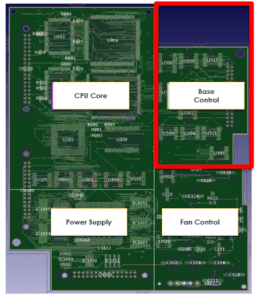It sounds like a paradox: electronics manufacturers can increase variation within a product line while using fewer electronic components. Reuse keeps product costs low, increases product flexibility and customization. Far from paradoxical, the approach is quite doable today through a process called modular board design coupled with predictive analysis numbers returned by the Internet of Things.
Modular board design for improved function
Modular board design strikes the balance between two of the greatest challenges electronics manufacturers face today: to produce a variety of products at competitive prices. The method also cuts manufacturing problems and allows companies to bring products to market faster than ever before.
A modular system partitions the overall product or component into discrete, scalable, and reusable design modules, which include designs for boards within resistors, actuators, and integrated circuits—designs used again and again within a company’s product line. Engineers create the designs for these modules and then store them within a central library.
Then, rather than pulling components from a library of resistors and integrated circuits, the engineer pulls from the library of design modules. From there the engineer places the already-designed modules within the design for, say, an actuator, when needed.
Because they’re always available, are placed in a number of different designs, and are expected to operate at peak performance, the modules within the library must be optimized on a regular schedule. After all, when the individual modules that make up the component, part, or design, are optimized, the overall design itself is closer to functioning within specification.
Enter the Internet of Things
But no module can do it all. That’s why the engineer still needs to know exactly which module to use for the product he or she is creating. To determine that, he or she needs to know at what point a specific module will fail. A module that can’t withstand a certain number of rotations can’t be used within a part that will greatly exceed that number of rotations, after all.
This is where IoT comes in. The IoT can automatically collect detailed performance information and tracks in high detail and in real time the performance of nearly every device—and every module within that device–at minimal cost.
Without the IoT, modular design wouldn’t be nearly as powerful. That’s because the IoT captures real-world performance data on how modules function within the equipment they’re already a used within.
Predicting failure
The IoT data allows engineers to predict, based on a product, the module’s history–the point at which it will fail–and to determine the reason for the failure, known as failure analysis.
By knowing the point at which a module will fail, engineers can then choose the proper module for their component. They can even redesign the electronic modules, so they no longer fail in the way they’ve commonly failed in the past.
Let’s take the example of a board with four modules: the CPU core, the power-supply section, the base control module, and the fan control module. Now let’s say an engineer intends to use that board within a furnace that must function for at least 30,000 heating cycles.
With the modular designs that already exist within furnaces can connect to the IoT. Or, engineers can use the IoT to run diagnostics on a design prototype. Let’s say the information returned finds that one of those four modules fail at around 22,000 heating cycles. It won’t make the grade. The board can’t be used within the engineer’s furnace design. The engineer knows he or she will need to use another modular board that has been shown to withstand 30,000 heating cycles.
You can see that this type of predictive analysis made possible by information returned by the IoT isolates the behavior of the module as compared to the component. This, of course, saves design time and allows the proper boards to be used within components from the start.
The engineer saves design time by spending time designing the component, knowing the board within that component will meet specification.
Once the product is in the field, the IoT information lets engineers know when a module is about to fail so it can be easily swapped out before it creates a catastrophic failure that affects the rest of the component, or even the entire assembly or product.
Herein lies the profit
Having optimized modules to fit most needs housed within a common available library allows engineers to build them once and share them across their organization. Given that 80 percent of product design is reused from version to version, there’s a good chance the module will be used again and again.
That reduction in design time makes it possible to bring products to market faster, to increase revenues and enables new products to gain market share before they face serious competition.
For the best in modular board design, you also need to make use of the predictive failure information made possible by the IoT. This can be a new—and entirely profitable—way to think about doing business.
Learn more about how CR-8000 can address your toughest challenges and help you put modular board design into practice.







